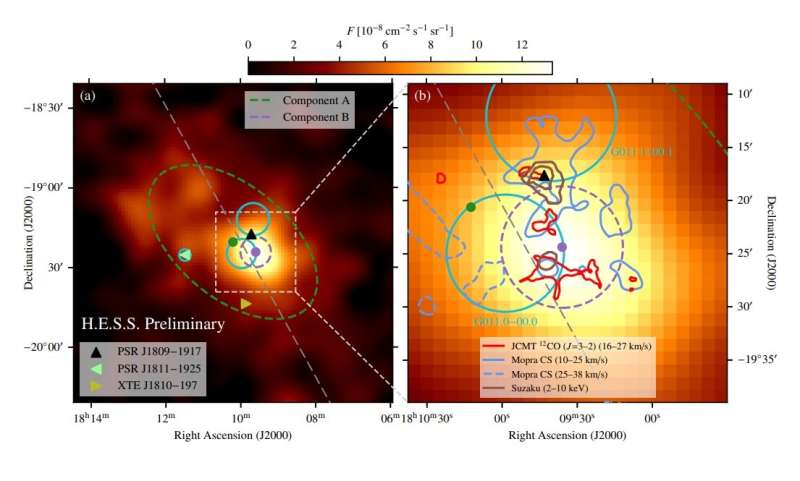Map showing the ?-ray flux above 0.27 TeV from HESS J1809−193.(a) full region. (b) zoom-in on core region. Credit: Mohrmann et al, 2023
Using the High Energy Stereoscopic System (HESS), German astronomers have investigated a very-high-energy (VHE) gamma-ray source known as HESS J1809−193. Results of the study, published January 18 on the arXiv preprint server, deliver important insights into the properties of gamma-ray emission from this source.
Sources emitting gamma radiation with photon energies between 100 GeV and 100 TeV are called very-high energy (VHE) gamma-ray sources, while those with photon energies above 0.1 PeV are known as ultra-high energy (UHE) gamma-ray sources. The nature of these sources is still not well understood; therefore, astronomers are constantly searching for new objects of this type to characterize them, which could shed more light on their properties in general.
Discovered in 2007 as part of the H.E.S.S. Galactic Plane Survey (HGPS), HESS J1809−193 is an unassociated VHE (over 100 GeV) gamma-ray source. Previous observations of HESS J1809−193 have found that the source is located in a rich environment, with an energetic pulsar (designated PSR J1809−1917) at a distance of some 10,750 light years, X-ray pulsar wind nebula (PWN), several supernova remnants (SNRs), and molecular clouds.
Recently, gamma-ray emission up to energies of about 100 TeV has been detected from HESS J1809−193 with the High Altitude Water Cherenkov (HAWC) observatory. The finding means that this source may be capable of accelerating cosmic rays up to PeV energies.
In order to verify this assumption, a team of astronomers led by Lars Mohrmann of the Max Planck Institute for Nuclear Physics in Heidelberg, Germany, has conducted follow-up observations of HESS J1809−193 using the HESS array of Cherenkov telescopes. Their study was complemented by data from NASA's Fermi spacecraft.
"We present a new analysis of the TeV gamma-ray emission of HESS J1809−193 with H.E.S.S., based on improved analysis techniques.... We used 93.2 h of data taken on HESS J1809−193 with the four 12 m diameter telescopes. For the high-level analysis, we have employed the Gammapy package and carried out a spectro-morphological likelihood analysis that uses as input a background model constructed from archival H.E.S.S. observations," the researchers explained.
The team managed to resolve the emission from HESS J1809−193 into two components (A and B) that exhibit distinct spectra and morphologies. The spectral indices of components A and B were measured to be at a level of 2.24 and 1.98, respectively. However, the astronomers noted that the upper limits at high energies for component A indicate that the spectrum may cut off before reaching 100 TeV.
According to the authors of the paper, the results suggest that the extended component A of HESS J1809−193 is compatible with a halo of old electrons surrounding a compact PWN. When it comes to the component B, they suppose that it could plausibly be of either leptonic or hadronic origin.
The researchers added that the presence of supernova remnants and molecular clouds in the HESS J1809−193 region indicates that a hadronic scenario should be considered, in which part of the emission may be due to cosmic-ray nuclei accelerated by the SNRs and interacting with gas in the clouds.
More information: Lars Mohrmann et al, Revisiting HESS J1809–193—a very-high-energy gamma-ray source in a fascinating environment, arXiv (2023). DOI: 10.48550/arxiv.2301.07366
Journal information: arXiv
© 2023 Science X Network
























